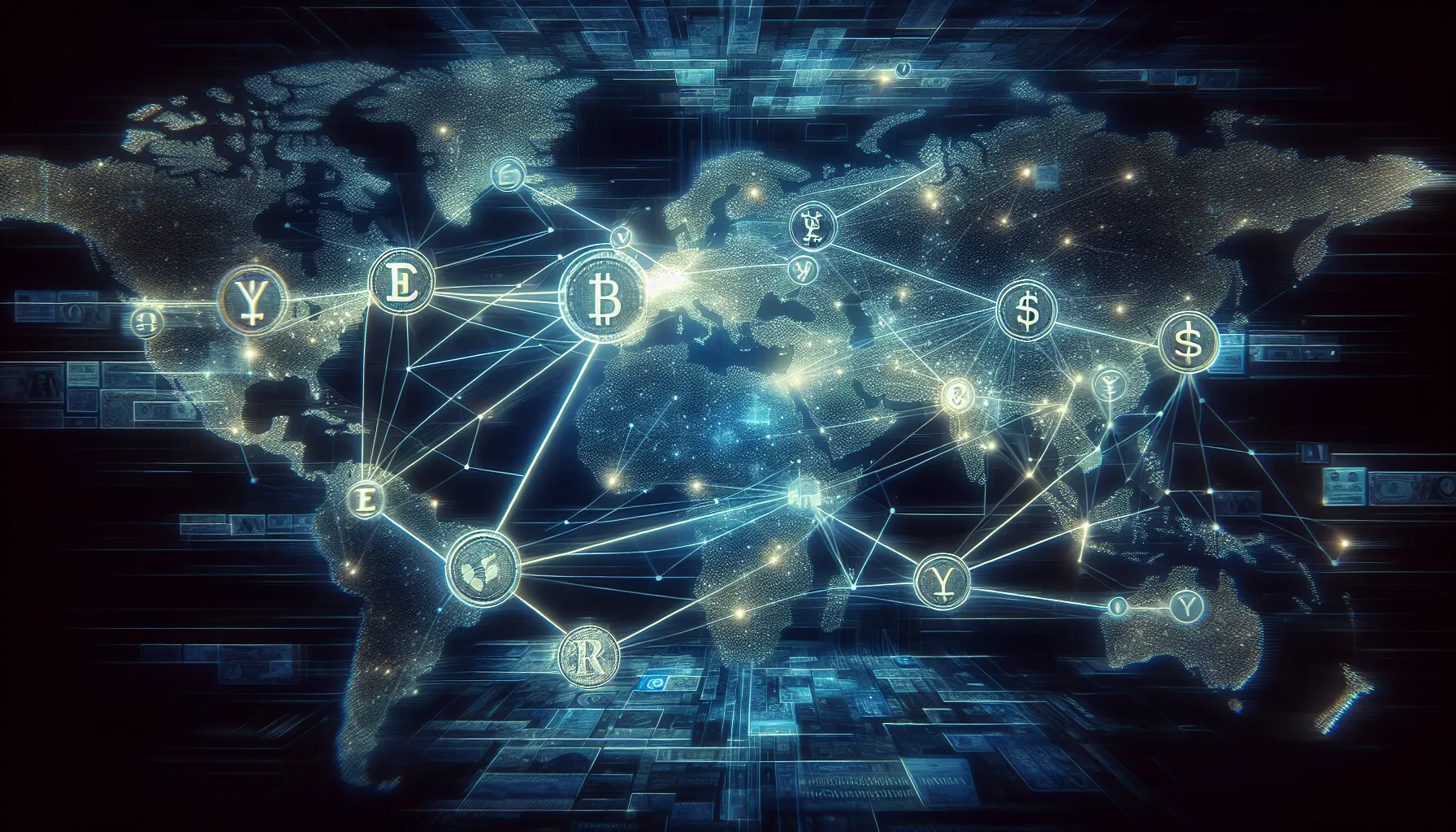Welcome to our IELTS Reading practice session focused on the fascinating topic of “Blockchain’s role in facilitating international remittances”. This article provides a comprehensive IELTS Reading test, complete with passages, questions, and answers, designed to help you prepare for the real exam while exploring an innovative financial technology.
 Blockchain and International Remittances
Blockchain and International Remittances
IELTS Reading Test: Blockchain and International Remittances
Passage 1 (Easy Text)
Blockchain technology has emerged as a groundbreaking innovation in the financial sector, particularly in the realm of international remittances. Remittances, which are money transfers made by foreign workers to their home countries, have traditionally been plagued by high fees and long processing times. However, blockchain is revolutionizing this process by offering a more efficient and cost-effective alternative.
At its core, blockchain is a decentralized digital ledger that records transactions across multiple computers. This technology eliminates the need for intermediaries, such as banks or money transfer operators, which typically charge high fees for their services. By leveraging blockchain, remittance providers can significantly reduce transaction costs and processing times.
One of the key advantages of blockchain-based remittances is transparency. All transactions are recorded on the blockchain and can be viewed by participants, making it easier to track the movement of funds. This increased visibility helps to mitigate fraud and ensures that money reaches its intended recipients.
Moreover, blockchain technology enables near-instantaneous transfers, regardless of geographical boundaries. Traditional remittance systems often involve multiple intermediaries and can take several days to process transactions. In contrast, blockchain-powered remittances can be completed in a matter of minutes or even seconds.
The adoption of blockchain in remittances also has the potential to promote financial inclusion. Many individuals in developing countries lack access to traditional banking services, making it difficult for them to receive money from abroad. Blockchain-based solutions can provide these unbanked populations with a secure and accessible means of receiving funds.
As the technology continues to mature, we can expect to see wider adoption of blockchain in the remittance industry. This shift has the potential to transform the global financial landscape, making international money transfers faster, cheaper, and more accessible to people around the world.
Questions for Passage 1
Multiple Choice
-
What is the main advantage of using blockchain for remittances?
A) Increased government regulation
B) Higher fees for transactions
C) Reduced costs and faster processing times
D) More intermediaries involved in the process -
How does blockchain technology improve transparency in remittances?
A) By keeping all transactions secret
B) By recording all transactions on a public ledger
C) By involving more banks in the process
D) By increasing government oversight
True/False/Not Given
- Blockchain technology completely eliminates the need for banks in remittances.
- Traditional remittance systems often take several days to process transactions.
- Blockchain-based remittances are only available to people with bank accounts.
Matching Information
Match the following features with the correct description. Write the correct letter A-D next to questions 6-9.
A) Decentralized digital ledger
B) Financial inclusion
C) Near-instantaneous transfers
D) Transparency
- Allows unbanked populations to receive funds securely
- Records transactions across multiple computers
- Enables quick money transfers across borders
- Makes it easier to track the movement of funds
Passage 2 (Medium Text)
The implementation of blockchain technology in international remittances has the potential to disrupt the traditional financial ecosystem. This innovative approach addresses several longstanding challenges associated with cross-border money transfers, including high costs, slow processing times, and lack of transparency.
One of the most significant advantages of blockchain-based remittances is the reduction in transaction fees. Traditional remittance services often charge exorbitant fees, sometimes reaching up to 7% of the transfer amount. These high costs disproportionately affect low-income migrants who send small amounts of money back home. Blockchain technology can dramatically reduce these fees by eliminating intermediaries and streamlining the process.
Furthermore, blockchain enables real-time settlement of transactions, a stark contrast to the current system where transfers can take several days to clear. This speed is particularly crucial in emergency situations where recipients may need immediate access to funds. The smart contract functionality of blockchain platforms can automate the execution of remittances based on predefined conditions, further enhancing efficiency.
The immutable nature of blockchain records also provides enhanced security and reduces the risk of fraud. Each transaction is cryptographically sealed and linked to previous transactions, creating a tamper-resistant chain of information. This feature is particularly valuable in regions where corruption and financial mismanagement are prevalent.
Despite its potential, the adoption of blockchain in remittances faces several challenges. Regulatory uncertainty remains a significant hurdle, as many countries are still developing frameworks to govern cryptocurrency and blockchain-based financial services. Additionally, the volatility of cryptocurrencies used in some blockchain remittance solutions can pose risks to users.
Scalability is another concern, as current blockchain networks may struggle to handle the volume of global remittance transactions. However, ongoing technological advancements, such as layer-2 solutions and more efficient consensus mechanisms, are addressing these limitations.
The integration of blockchain with existing financial systems is crucial for widespread adoption. Many traditional financial institutions are exploring partnerships with blockchain startups or developing their own solutions to stay competitive in this evolving landscape.
As blockchain technology continues to mature, its impact on international remittances is likely to grow. The potential for financial inclusion, reduced costs, and increased efficiency makes blockchain a promising solution for transforming the global remittance market.
Questions for Passage 2
Identifying Information (True/False/Not Given)
State whether the following statements are True, False, or Not Given based on the information in the passage.
- Blockchain technology completely eliminates all fees associated with remittances.
- Smart contracts can automate the execution of remittances.
- All countries have established clear regulations for blockchain-based financial services.
- Blockchain records are impossible to tamper with.
Matching Headings
Match the following headings with the correct paragraphs in the passage. Write the correct number (i-vii) next to questions 14-17.
i. Regulatory and technical challenges
ii. Cost reduction benefits
iii. Enhanced security features
iv. The future of blockchain in remittances
v. Speed and efficiency improvements
vi. Integration with traditional systems
vii. Introduction to blockchain remittances
- Paragraph 1
- Paragraph 2
- Paragraph 3
- Paragraph 7
Sentence Completion
Complete the sentences below using NO MORE THAN THREE WORDS from the passage for each answer.
- Traditional remittance services can charge fees of up to ___ of the transfer amount.
- The ___ of blockchain records helps reduce the risk of fraud.
- ___ remains a significant challenge for the adoption of blockchain in remittances.
- Blockchain technology has the potential to promote ___ by providing access to financial services for unbanked populations.
Passage 3 (Hard Text)
The paradigm shift brought about by blockchain technology in the realm of international remittances represents a confluence of technological innovation and economic necessity. As global migration continues to increase, the demand for efficient, cost-effective remittance solutions has never been more pressing. Blockchain offers a decentralized alternative to traditional remittance systems, promising to democratize access to financial services and reshape the global economic landscape.
The underlying architecture of blockchain technology is particularly well-suited to address the inherent inefficiencies in conventional remittance networks. By utilizing a distributed ledger system, blockchain eliminates the need for a centralized authority to validate and process transactions. This disintermediation not only reduces costs but also mitigates the risk of single points of failure that can plague centralized systems.
Moreover, the cryptographic foundations of blockchain provide a robust security framework that is resistant to tampering and fraud. Each transaction is verified and recorded across multiple nodes in the network, creating an immutable audit trail. This level of transparency and security is particularly valuable in regions where financial infrastructure is underdeveloped or where there is a lack of trust in traditional banking systems.
The potential of blockchain to facilitate financial inclusion extends beyond mere cost reduction. By leveraging mobile technology and digital wallets, blockchain-based remittance solutions can reach unbanked and underbanked populations, providing them with access to essential financial services. This has profound implications for economic development, as remittances often serve as a lifeline for families in developing countries.
However, the integration of blockchain into the global remittance ecosystem is not without challenges. The regulatory landscape surrounding blockchain and cryptocurrencies remains fragmented and uncertain. Different jurisdictions have adopted varying approaches, ranging from embracing the technology to imposing strict regulations or outright bans. This regulatory heterogeneity creates significant obstacles for companies seeking to implement blockchain-based remittance solutions on a global scale.
Furthermore, the technical complexity of blockchain technology presents barriers to widespread adoption. Issues of scalability and interoperability must be addressed to handle the volume and diversity of global remittance transactions. Initiatives such as the Lightning Network and other layer-2 solutions are being developed to enhance the scalability of blockchain networks, but their efficacy in real-world remittance scenarios remains to be fully proven.
The volatility of cryptocurrencies, which are often used as intermediaries in blockchain-based remittances, poses another challenge. Rapid fluctuations in value can expose users to significant exchange rate risks, particularly in transactions that are not settled instantaneously. Stablecoins have emerged as a potential solution to this problem, offering the benefits of blockchain technology while maintaining a stable value pegged to fiat currencies.
Despite these challenges, the potential for blockchain to revolutionize the remittance industry remains significant. As the technology matures and regulatory frameworks evolve, we can expect to see increased integration of blockchain solutions into existing financial systems. This convergence of traditional finance and blockchain technology has the potential to create a more inclusive, efficient, and transparent global remittance network.
The long-term implications of blockchain-powered remittances extend beyond the financial sector. By reducing the cost of sending money across borders, blockchain technology could stimulate economic growth in developing countries, foster entrepreneurship, and contribute to poverty reduction. Moreover, the increased transparency and traceability of blockchain transactions could aid in combating money laundering and terrorist financing, addressing key concerns of regulatory bodies worldwide.
As we stand on the cusp of this technological revolution, it is clear that blockchain has the potential to fundamentally alter the landscape of international remittances. While challenges remain, the promise of a more inclusive, efficient, and equitable global financial system makes the continued exploration and development of blockchain-based remittance solutions an imperative for the 21st century.
Questions for Passage 3
Matching Features
Match the following features with the correct descriptions. Write the correct letter A-G next to questions 22-26.
A) Distributed ledger system
B) Cryptographic foundations
C) Mobile technology and digital wallets
D) Lightning Network
E) Stablecoins
F) Regulatory heterogeneity
G) Volatility of cryptocurrencies
- Provides security and resistance to tampering in blockchain transactions
- Aims to improve the scalability of blockchain networks
- Enables blockchain-based remittances to reach unbanked populations
- Creates obstacles for global implementation of blockchain remittances
- Offers stability in value for blockchain-based transactions
Summary Completion
Complete the summary below using words from the box. Write the correct letter A-L next to questions 27-32.
A) centralized B) decentralized C) intermediaries D) transparency E) scalability
F) regulatory G) volatility H) stablecoins I) integration J) financial inclusion
K) economic L) global
Blockchain technology offers a (27)__ alternative to traditional remittance systems, eliminating the need for (28)__ and reducing costs. The technology’s cryptographic foundations provide enhanced security and (29)__, which is particularly valuable in regions with underdeveloped financial infrastructure. However, challenges such as (30)__ uncertainty and issues of (31)__ must be addressed. Solutions like (32)__ have emerged to combat the problem of cryptocurrency volatility in remittances.
Diagram Label Completion
Complete the labels on the diagram below using NO MORE THAN TWO WORDS from the passage for each answer.
[Diagram showing the flow of blockchain-based remittances]
- Sender initiates transaction using and
- Transaction is verified across multiple ___
- ___ may be used to stabilize value during transfer
- Recipient receives funds, promoting ___
- Entire process contributes to ___ in developing countries
Answer Key
- C
- B
- False
- True
- Not Given
- B
- A
- C
- D
- False
- True
- False
- True
- vii
- ii
- v
- iv
- 7%
- immutable nature
- Regulatory uncertainty
- financial inclusion
- B
- D
- C
- F
- E
- B
- C
- D
- F
- E
- H
- mobile technology, digital wallets
- nodes
- Stablecoins
- financial inclusion
- economic growth
This IELTS Reading practice test on “Blockchain’s role in facilitating international remittances” provides a comprehensive exploration of the topic while testing various reading skills. The passages progress from easy to hard, mimicking the structure of the actual IELTS Reading test. By practicing with this material, test-takers can improve their understanding of complex financial technology concepts while honing their reading comprehension skills for the IELTS exam.


